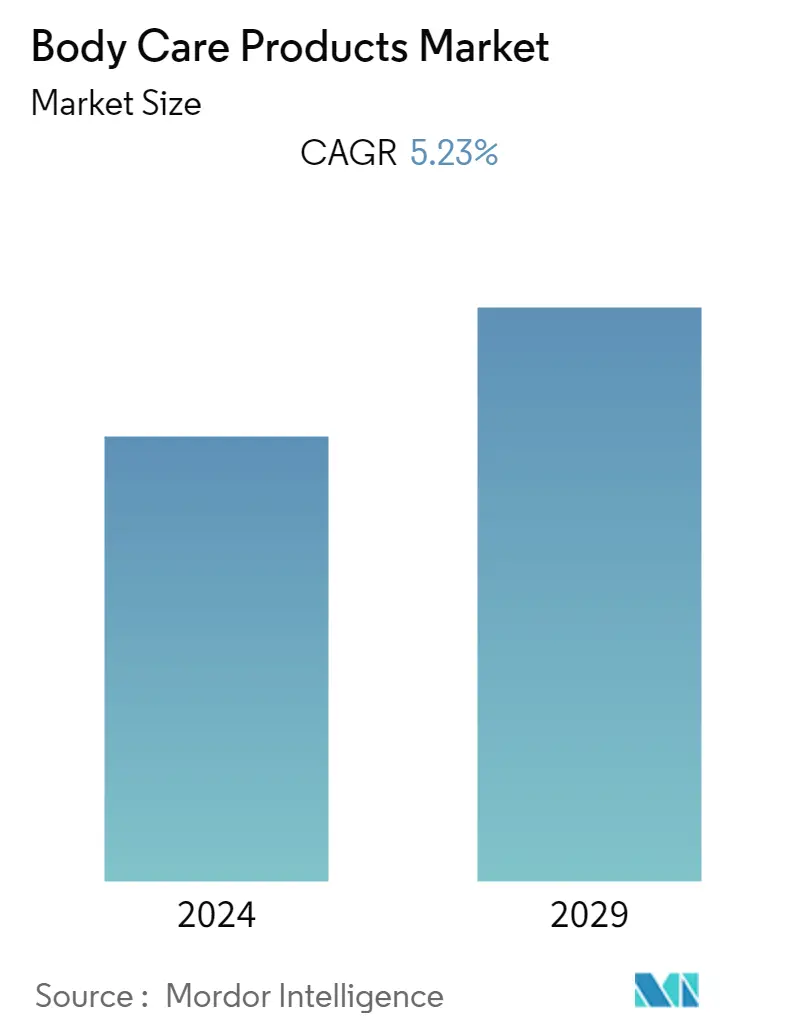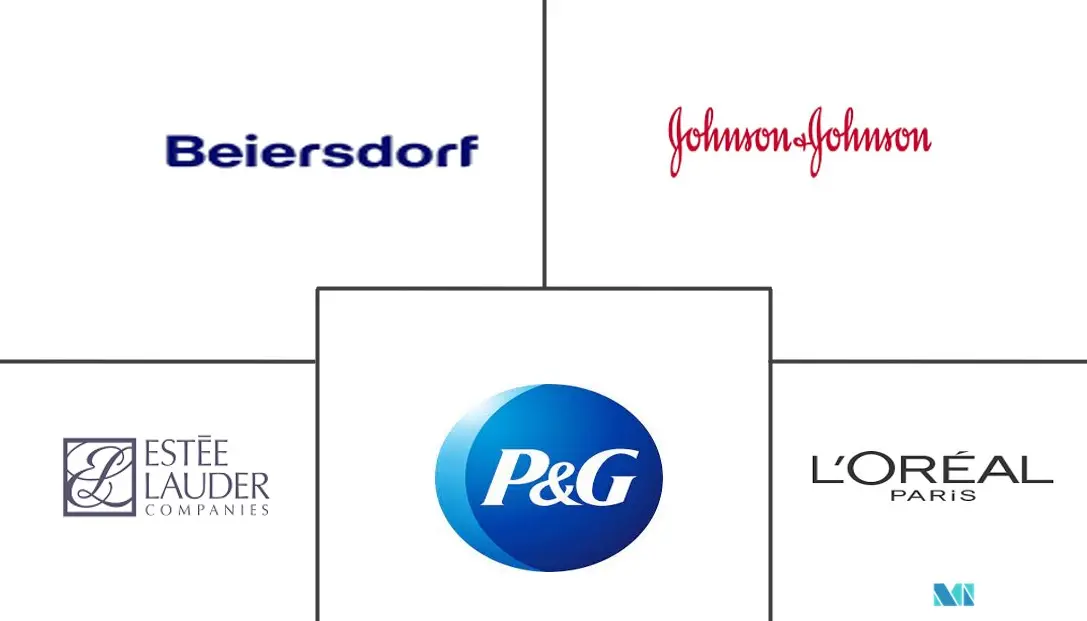Market Size of Body Care Products Industry

| Study Period | 2019 - 2029 |
| Base Year For Estimation | 2023 |
| CAGR | 5.23 % |
| Fastest Growing Market | Asia-Pacific |
| Largest Market | North America |
| Market Concentration | High |
Major Players
*Disclaimer: Major Players sorted in no particular order |
Body Care Products Market Analysis
Body care products market is projected to register a CAGR of 5.23% during the forecast period, 2022-2027.
Over the past few years, the demand for body creams, lotions, and powder has been growing due to the growing consumer demand for maintenance products that can help to improve personal aesthetics and hygiene. Apart from the skin and hair care routine, consumers are also shifting their focus toward hand care, as the skin on the hands constantly remains in contact with chemicals, dirt, dust, and oils, among others owing to the increased pollution.
Moreover, the increasing consumer awareness about skin rituals and the growing demand for natural and organic skincare products have been driving the growth of this market. Additionally, hand creams come with a lot of nourishing properties that protect the hands from excessive dryness, cracks, and chapping.
Body Care Products Industry Segmentation
Body care products are designed with specific functions, including supporting skin integrity, enhancing its appearance, and relieving skin conditions. The global body care products market (henceforth referred to as the market studied) is segmented by product type, category, distribution channel, and geography. By product type, the market is segmented into moisturizer, body cream, powders, body wash, soaps, and others. By category, the market is segmented into conventional and natural/organic. Based on the distribution channel the market studied is segmented into supermarkets/hypermarkets, specialty Stores, online retail stores, and others. It provides an analysis of emerging and established economies across the world, comprising North America, Europe, South America, Asia-Pacific, and the Middle East and Africa. For each segment, the market sizing and forecasts have been done based on value (USD million).
| By Product type | |
| Moisturizer | |
| Body Cream | |
| Powders | |
| Body Wash | |
| Soaps | |
| Others |
| By Category | |
| Conventional | |
| Natural & Organic |
| By Distribution Channel | |
| Supermarkets/Hypermarket | |
| Specialiaty Stores | |
| Online Retail Stores | |
| Other Distribution Channels |
| By Geography | |||||||||
| |||||||||
| |||||||||
| |||||||||
| |||||||||
|
Body Care Products Market Size Summary
The body care products market is experiencing significant growth, driven by an increasing consumer focus on personal aesthetics and hygiene. This trend is evident in the rising demand for body creams, lotions, and powders, as well as a shift towards hand care products due to heightened exposure to pollutants and chemicals. The market is further bolstered by a growing awareness of skin care rituals and a preference for natural and organic products, as consumers become more conscious of the potential adverse effects of chemical ingredients. The demand for vegan and chemical-free products has surged, with organic body lotions gaining popularity for their nourishing properties and use of natural ingredients like shea butter and aloe vera. This shift has prompted companies to introduce organic body care lines, catering to the evolving preferences of health-conscious consumers.
The competitive landscape of the body care products market is marked by the presence of numerous regional and global players, including industry giants such as L'Oréal S.A., Procter & Gamble Co, and Unilever PLC. These companies are actively expanding their product offerings and market presence to meet consumer demands and capture significant market shares. The Asia-Pacific region, in particular, is witnessing robust growth due to lifestyle changes, the influence of foreign brands, and a preference for organic and herbal ingredients. Key players are investing in research and development to create innovative products that address specific consumer needs, while also enhancing their digital presence to engage with a broader audience. The introduction of new product lines, such as those by Samisha Organic and WK Life, highlights the ongoing innovation and diversification within the market.
Body Care Products Market Size - Table of Contents
-
1. MARKET DYNAMICS
-
1.1 Market Drivers
-
1.2 Market Restraints
-
1.3 Porter's Five Force Analysis
-
1.3.1 Threat of New Entrants
-
1.3.2 Bargaining Power of Buyers/Consumers
-
1.3.3 Bargaining Power of Suppliers
-
1.3.4 Threat of Substitute Products
-
1.3.5 Intensity of Competitive Rivalry
-
-
-
2. MARKET SEGMENTATION
-
2.1 By Product type
-
2.1.1 Moisturizer
-
2.1.2 Body Cream
-
2.1.3 Powders
-
2.1.4 Body Wash
-
2.1.5 Soaps
-
2.1.6 Others
-
-
2.2 By Category
-
2.2.1 Conventional
-
2.2.2 Natural & Organic
-
-
2.3 By Distribution Channel
-
2.3.1 Supermarkets/Hypermarket
-
2.3.2 Specialiaty Stores
-
2.3.3 Online Retail Stores
-
2.3.4 Other Distribution Channels
-
-
2.4 By Geography
-
2.4.1 North America
-
2.4.1.1 United States
-
2.4.1.2 Canada
-
2.4.1.3 Mexico
-
2.4.1.4 Rest of North America
-
-
2.4.2 Europe
-
2.4.2.1 United Kingdom
-
2.4.2.2 Germany
-
2.4.2.3 Spain
-
2.4.2.4 France
-
2.4.2.5 Italy
-
2.4.2.6 Russia
-
2.4.2.7 Rest of Europe
-
-
2.4.3 Asia-Pacific
-
2.4.3.1 China
-
2.4.3.2 Japan
-
2.4.3.3 India
-
2.4.3.4 Australia
-
2.4.3.5 Rest of Asia-Pacific
-
-
2.4.4 South America
-
2.4.4.1 Brazil
-
2.4.4.2 Argentina
-
2.4.4.3 Rest of South America
-
-
2.4.5 Middle East & Africa
-
2.4.5.1 United Arab Emirates
-
2.4.5.2 South Africa
-
2.4.5.3 Rest of Middle East & Africa
-
-
-
Body Care Products Market Size FAQs
What is the current Body Care Products Market size?
The Body Care Products Market is projected to register a CAGR of 5.23% during the forecast period (2024-2029)
Who are the key players in Body Care Products Market?
Beiersdorf AG, Proctor & Gamble Company , Johnson & Johnson Services Inc, L’Oréal SA. and The Estée Lauder Companies Inc are the major companies operating in the Body Care Products Market.

